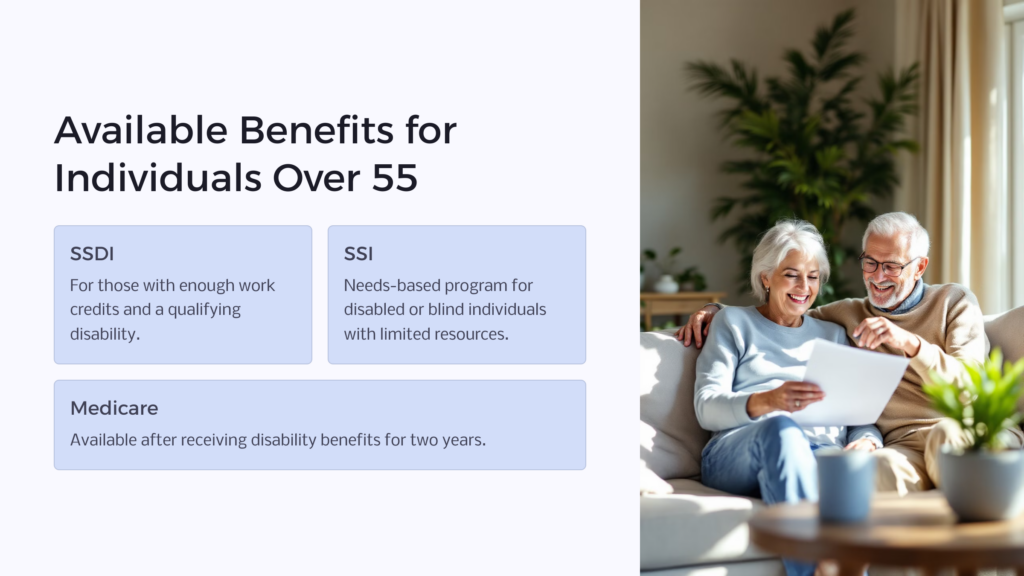Qualifying for disability benefits after age 55 is easier than in your twenties or thirties, thanks to special rules known as the medical-vocational grid. These rules target people in their retirement age who can’t perform their previous jobs. The grid rules allow the Social Security Administration (SSA) to consider factors that make it daunting for these people to switch jobs. These factors include whether they have adequate skills that transfer to other jobs.
Although younger people must prove that they can’t perform the easiest sit-down jobs before the Social Security Administration can deem them disabled, people closer to the retirement age might be disabled even though they can do sit-down jobs. And if you’re 55 and can perform half-sitting, half-standing jobs, you can still be eligible for disability benefits. If you have questions about the special Social Security Disability (SSD) rules and how they may affect you and your loved ones, contact us today for a free consultation.
Understanding Social Security Disability Rules After Age 55

To qualify for Social Security Disability benefits (SSDI), you must have a disability that meets the requirements established under the Social Security Act. You must have medical evidence proving that you have a mental impairment or medically determinable physical that hinders you from performing substantial gainful activities. The impairment should last for a year or result in death.
Additionally, these specific changes and considerations influence your likelihood of collecting disability benefits after reaching the age of 55:
- Your Ability to Work: First and foremost, the Social Security Administration determines if you’re deemed disabled by its requirements. The SSA investigates whether your mental or physical impairment hinders you from performing a substantial gainful activity (SGA). This encompasses the income you earn even though you’re disabled. If you can still perform SGA despite your disability, you won’t be considered disabled.
- Duration and Severity of Disability: The SSA also assesses the severity and duration of your mental or physical disability. To be deemed severe, the impairment must significantly affect your daily life. Further, the severity of your medical condition should be expected to last for 12 months or more. People over 55 are more likely to have severe physical or mental impairment. The SSA will analyze your condition to see if it meets or equals one of the impairments in the Blue Book. The Blue Book lists all medical conditions and illnesses that would qualify an individual to be found disabled by the SSA and thus qualify for disability benefits.
- Present Performance Compared to Past Performance: The Social Security Administration also determines if your disability hinders you from performing the work you were able to perform within the last 15 years. Finally, it determines if your disability hinders you from performing any other type of work.
- Rules Determining your Ability to Work: Again, the SSA uses “grid rules,” also known as medical-vocational guidelines, to assess your work ability, the level of exertion you’re capable of, and other factors. The grid is a chart that features different Social Security disability rules for various age brackets and different RFC (residual functioning capacity) levels. These rules favor applicants who are at and older than 55, have transferable work skills, and are limited to sedentary work. If you’re over 55 and have a disabling medical condition, but your medical condition doesn’t meet or equal a medical condition listed in the Blue Book, grid rules will apply. The Social Security Administration will look at your age and consider your skill level, education, and if your work skills are transferable to another job. They’ll use that information to determine if you can be deemed disabled by their standards.
- RFC: Residual functioning capacity is the level of physical exertion an individual can work at regardless of their limited ability because of mental or physical impairment. Your RFC is based on how much weight you can lift. Depending on the weight you can lift and how frequently, the SSA may find you capable of light, sedentary, medium, heavy, or very heavy work levels. Your exertional level is an integral part of your RFC. The SSA uses five exertional levels:
- Sedentary Work: This type of work requires you to lift a maximum of 10 pounds and walk or stand for 2 hours.
- Light Work: This type of work requires lifting a maximum of 20 pounds and walking or standing for 6 hours.
- Medium Work: This type of work requires you to lift a maximum of 50 pounds and walk or stand for a maximum of 6 hours.
- Heavy Work: This type of work requires you to lift a maximum of 100 pounds and walk or stand for 6 hours total.
- Very Heavy Work: This type of work requires you to lift over 100 pounds and walk or stand for a maximum of 6 hours.
Under the grid rules, you won’t qualify for SSDI benefits after age 55 if you can perform heavy or very hard work. You’ll be eligible for these benefits if you can do medium work, especially if you have limited education and never worked before. However, suppose you can only do sedentary or light work. In that case, Social Security will use grid rules to see if they can “direct a finding of disability” based on other factors, like your education level.
The SSA uses grid tables to determine if an applicant is disabled and meets a listing in the Blue Book.
Additionally, the SSA uses various characteristics like an applicant’s education level, age, past employment skills, and residual functioning capacity (RFC) test results.
For individuals under 50 years, the grid tables aren’t much help because the SSA always considers this age group “not disabled.”
Older Persons Have a Greater Chance of Qualifying
As you get closer to more advanced age and eventually to retirement age, the odds of qualifying for disability benefits increase. The Social Security Administration (SSA) considers any person in the 55 to 59 years age bracket as being of advanced age.
The rules favor a person who is 55 years or older. Suppose a person aged 55 or older is limited to only doing sedentary work or less and lacks work skills to help them transition to another type of job. In that case, they’re more likely to qualify for Social Security disability benefits.
If, after reviewing your claim for disability benefits after age 55, the SSA concludes your medical condition doesn’t meet its Blue Book listing, but you can’t do your past job, the SSA will apply the grid rules to decide if you’re disabled.
Fortunately, if you’re 55 and older, Social Security disability rules after age 55 make it easier for you to qualify for SSDI benefits when your application gets to step five in the review process. Social Security recognizes employers’ reluctance to hire older employees to do jobs if they lack experience. It might not pay for an organization to train an employee who might qualify for Social Security disability benefits for seniors. This advantage becomes more likely for employees closer to early or full retirement age.
No matter any advantage SSD rules after age 50 may offer in the application process, your application can be denied. If that happens, contact us to learn more about your legal options to appeal the decision.
Qualifications for Social Security Disability Benefits Over Age 55

To be eligible for SSD benefits, you must have a complete disability. That means that your disabling condition:
- Hinders you from engaging in substantial gainful activity
- It hinders you from doing the job you used to do
- Hampers you from adjusting to a new job
- Is likely to go on for 12 months or more or even result in death
Sadly, a qualifying condition is one that significantly hinders your ability to perform basic work-related activities like standing, sitting, lifting, walking, focusing, or remembering things for at least a year.
The SSA provides monthly benefits to anyone in need who can’t work because of their disabling condition. If you’re over 55 and have any of these medical conditions, there’s a good chance you’ll qualify for disability benefits for seniors:
- Arthritis. Musculoskeletal disabilities like arthritis are the most commonly approved disabilities for SSDI benefits. You’ll qualify for disability benefits after 55 if you can’t walk or perform dexterous activities like writing or typing because of arthritis.
- Heart disease. Many kinds of heart diseases qualify for disability benefits like congestive heart failure or congenital heart defects.
- Respiratory illness. Many people with respiratory diseases qualify for Social Security disability benefits.
- Degenerative disc disease. This is another type of musculoskeletal disorder that often affects people over 55. If you have this condition, you can qualify for SSD benefits if you can prove that you can’t sit in one position for over two hours because of pain.
- Mental illness. Nearly 20% of those who receive Social Security disability benefits have mental conditions like autism or mood disorders such as anxiety or depression. While a mental illness doesn’t guarantee eligibility for disability benefits for seniors, it’s still one of the top mental conditions that qualify for SSD benefits.
Other conditions that qualify for Social Security disability benefits include cancer, nervous system disorders, stroke, and immune system disorders like autoimmune diseases or HIV. Additionally, if you have a medical condition that’s severe enough to prevent you from working for at least one year, you’ll qualify for disability benefits.
Further, some medical conditions, like ALS, advanced cancer, Parkinson’s, blindness, cardiovascular system disorders, chronic heart failure, and dementia, qualify for expedited disability benefits.
If you’re disabled and can’t work because of any of the above-mentioned disabling conditions, you can apply for and get disability benefits from the SSA. If you’re approved to receive disability benefits, you’ll find these benefits immensely helpful in alleviating the economic burden that often comes with being disabled.
To qualify and receive your disability benefits for as long as you need them, you must participate in the “Continuing Disability Review” or CDR. The SSA uses this process to ensure people continue to meet the requirements that qualify them to receive disability benefits. The SSA will discontinue disability benefits if it determines you no longer have a disabling condition.
The law requires the SSA to perform a CDR every three years. During the CDR, the SSA will analyze evidence about one’s medical condition. It’ll also review their living conditions, income, and other relevant factors that qualify them for SSDI benefits after age 55.
After conducting an initial CDR, the SSA decides if your medical condition is permanent or likely to improve. The SSA often assigns every newly approved disability claim to one of these three medical improvement categories:
- Medical improvement expected: These conditions respond well to treatment or resolve quickly on their own. Claims assigned to this category are scheduled for review at least six months and not longer than 18 months.
- Medical improvement possible: These include medical conditions that are severe and not permanent. Reviews of these claims are conducted every three years.
- Medical improvement not expected: Often, disability claims are placed in this category when based on medical evidence and opinion, a person’s condition is likely to remain unchanged or worsen. Thus, reviews of these cases are conducted every 5 to 7 years.
Apart from looking at the medical condition, the SSA also considers a person’s age as part of the evaluation process.
To learn more about Social Security disability rules, check out this article on disability defined by age.
Available Benefits for Individuals Over Age 55

Individuals suffering from disabling conditions may qualify for SSDI and Supplemental Security Income (SSI) compensation. Many people who qualify for SSI benefits are blind or disabled, but Supplemental Security Income is also for those over 55 with little resources or income. To qualify for disability benefits under either program, you must suffer from a medical condition expected to last at least 12 months or result in death.
The SSI program offers a minimum basic monthly income to elderly income-limited adults. It is one of the most extensive federal aid for people of all ages who are disabled or blind. This program is needs-based, which means only those with limited resources and income can qualify.
SSDI benefits individuals with disabilities who have gained enough work credits to qualify.
The SSA considers people aged 55 to be disabled if they suffer from a physical or mental condition that:
- Causes inability to perform any substantial gainful activity; and
- Is expected to cause death; or
- It has lasted or is likely to last for not less than one year.
Since the Social Security Act defines disabling conditions so strictly, SSDI recipients are the most severely impaired in the nation. SSDI recipients are three times more likely to die in a year than other people in the same age bracket. Among those who start collecting SSDI benefits, one in eight women and one in six men die within five years of the onset of their disabling condition.
Often, as you get older, it becomes easier to qualify for SSDI or SSI benefits. That’s because special Social Security disability rules apply if you’re over 50, 55, or 60.
Further, if you receive Social Security disability insurance (SSDI) benefits when you reach full retirement age, your SSDI benefits will automatically convert to retirement benefits. However, the amount remains the same.
Medicare is also available to older people with specific disabilities. These persons must have received disability benefits for two years and have Amyotrophic Lateral Sclerosis or End Stage Renal Disease. Without Medicare, many older adults wouldn’t afford the routine healthcare required to maintain good health.
Seniors over 55 can also qualify for veteran-specific financial aid if they have served in the military.
Social Security Disability Rules After Age 62
For older employees, especially those aged 62 and older, SSA must consult various rules called “grid rules” to determine if an individual is disabled. Grid rules are a series of rules that consider a disability claimant’s age, education, residual functional capacity, and work experience to establish whether the claimant should receive disability benefits or not.
These claiming age rules make it easier for claimants over the age of 62 to receive Social Security disability benefits because SSA considers it challenging for older employees to acquire new skills and transition into new jobs. However, if you were a skilled worker before you became disabled and you can transfer your skills to a less demanding job, you won’t qualify for disability benefits just because you’re 62 or older.
Here’s what Social Security disability rules look at after age 62:
- Residual functional capacity. A claimant’s RFC refers to the amount of physical work they can do on a sustained and regular basis. Again, an RFC can be for light, sedentary, medium, heavy, or very heavy work. If you can still do heavy or very heavy work, you won’t qualify for disability benefits under grid rules, regardless of your age. On the flip side, if you can only do sedentary or light work, you’ll be considered disabled if you’re over 62 and don’t have a high school education; especially if you have no work skills and can’t apply for another job.
- Education. Social Security categorizes education levels into having a 6th-grade education or less, having studied up to grade 7 or 11, completed high school, and being a high school graduate with recent schooling or training that qualifies for skilled work. Suppose you graduated high school and have recent training that would enable you to transition into skilled work. In that case, you won’t be considered disabled under Social Security disability rules, even though you might be medically eligible for disability benefits in other ways.
- Past work experience. If you can do medium work and didn’t graduate high school, whether Social Security disability rules deem you disabled largely depends on the kind of work you’ve done in the past. SSA will look at previous jobs you’ve done to ascertain if you did skilled, unskilled, or semi-skilled work. SSA allocates skill levels based on how long you took to learn your job. If you took a lot of time to learn your job or if you required specialized education to learn your job, the higher skill level you have. Often, it’s easier for those who did unskilled work to qualify for Social Security disability benefits under the grid rules.
- Transferable skills. Again, Social Security considers if you can easily apply your work skills in another position. If you can, Social Security calls those skills “transferable,” and you won’t qualify for disability benefits under grid rules. Often, those who did skilled or semi-skilled jobs will have gained skills they can use elsewhere. This makes it difficult for them to get approved for disability benefits under the grid rules. However, some semi-skilled and skilled jobs are so specialized that the Social Security Administration will conclude that the employee doesn’t have transferable skills, like seamstress work.
In addition to the above rules, the SSA can use the “worn out employee” to approve benefits for claimants whose primary work was physical labor and who only have marginal education. This consideration allows for expedited approval of disability benefits if the claimant meets the following criteria:
- The applicant didn’t go beyond the sixth grade in school
- The applicant has worked for over 35 years doing primarily arduous unskilled physical labor
- The applicant can’t do their job because of their mental or physical impairments
However, if SSA determines that your disabling condition doesn’t hinder your performance at your past job for at least a year, your application will be denied. Here, the SSA doesn’t have to follow the grid rules because they establish if you can adjust to a new job.
Tips for Successfully Applying for Disability Benefits After Age 55

The SSA receives millions of applications every year. However, the rate of claimants getting approved for Social Security disability benefits remains slim, averaging about 36% of claims filed between 2004 and 2013. Thus, successfully applying for disability benefits is a daunting task.
Thankfully, with these five tips, you can improve your chances of getting approved for Social Security disability benefits regardless of your age.
- Know What You Need to Get Approved
Again, to meet SSA’s definition of disability, you should:
- Have a severe mental or physical disability
- That’s likely to last at least a year and cause death, and
- That equals or meets a medical condition listed on the Blue Book or hinders your earning income that’s more than the substantial gainful limit.
If you have an extremely severe medical condition, such as a rare disease or advanced cancer, a Compassionate Allowance can help you fast-track your application to the front line. Often, SSA approves these claims quickly.
However, if you don’t have a listed or compassionate allowance condition, you must prove that you can’t sustain any regular work, including a simple, unskilled job. However, the SSA relaxes this criterion if you’re 55 or older.
- Find What Programs You Might Qualify For
If you’ve worked for many years and paid Federal Insurance Insurance Contributions (FICA) payroll taxes, you may have adequate credits in the Social Security System to apply for disability benefits. You can earn at least four credits a year with sufficient income, improving your eligibility for Social Security disability benefits. You need five years of credit or 20 credits from the last ten years. Your disability benefit amount will largely depend on the FICA tax you’ve paid.
If you don’t have enough credits, you can apply for SSI. This flat benefit amount caters to food and housing expenses. However, there is a limit of $3,000 for a couple or $2,000 for an individual. Once Social Security approves your claim, you’ll receive SSI benefits from the date you sent your application. However, if you aren’t paying a fair share of household expenses, your SSI benefits will be reduced by one-third.
- Maintain Good Healthcare
Your claim is only as good as the consistent and ongoing record of your disabling condition (s). Thus, if you lose healthcare insurance because of your medical condition, apply for Medicaid, which is readily available to most uninsured low- or no-income Americans.
After you’re approved for Medicaid, schedule appointments with medical specialists that treat each of your medical conditions. Adhere to your treatment plan. Avoid rescheduling if necessary, and don’t cancel appointments. That’s because Disability Determination Services will gather and examine your medical records thoroughly to establish if your disabling condition meets Social Security’s requirements. Significant gaps in your treatment plan can lower your chances of getting approved for disability benefits.
- Educate Your Medical Specialist About Your Limitations and Conditions
Your treatment records must support the disabling conditions you claim to suffer from. To educate your doctors and other medical specialists about your condition and improve your medical records, you must have a list of all your symptoms, their severity and frequency, and how they hinder you from performing basic work-related activities.
Update your list regularly and share it with your medical specialists at every appointment so that they document how your disability affects you. Symptoms include things like weakness, dizziness, insomnia, pain, anxiety, depression, irritability, memory loss, and difficulty with focus. Limitations can include things like difficulties cooking, cleaning your house, or bathing; walking, sitting, or standing for extended periods; getting along with others; driving for more than a mile or two; or recalling important things or paying attention. The more you record every limitation and symptom, the better your chances of receiving disability benefits.
- Understand the Complex Process and Hang In There!
Qualifying for Social Security disability benefits after 55 or any other age takes time. Once you send your application, a decision can take up to four months. Many people are denied, particularly those with poor documentation. If your claim is denied, you can appeal within 60 days. That appeal is known as the Request for Reconsideration, and it requires another two to four months to get a decision.
You can appeal again within 60 days if your appeal is also denied. This appeal is known as the Request for a Hearing with a Social Security judge and can take 12 months or more to schedule. This is often a face-to-face hearing with an Administrative Law judge. For each appeal, be sure to submit more records to prove your claim. If you have to go for a hearing, seek legal help from an attorney with extensive experience and expertise in Social Security and even your specific medical condition.
Conclusion: Social Security Disability Rules After 55
Aging is a substantial asset when applying for disability benefits. That’s because the SSA makes it easier for applicants over the age of 55 to receive Social Security disability benefits. SSA views many years of work experience as a good thing and strives to reward the achievement of disabled employees over the age of 55 who need SSD benefits.
The SSA appreciates that it’s challenging for senior, disabled employees to transition to a new job. Thus, the SSA sets the requirements for disability benefits for those over 55 at a lower level, making it easier to get approved for the much-needed financial help.
When evaluating eligibility for disability payments, the SSA considers age as well as other factors like previous work experience, education, mental and physical ability, severity and duration of disability, and RFC. The SSA also considers an individual’s ability to do any work, not just their past job.
However, this doesn’t mean your application will be approved just because you’re older. The SSA denies many disability claims every year. To increase your chances of getting approved for disability benefits, ensure you know what you need to prove to get approved for Social Security disability benefits and educate your doctors about your symptoms and limitations. For more information on how to qualify for Social Security disability benefits after 55, visit Benefits.com for a free report.
 Benefits.com Advisors
Benefits.com Advisors
With expertise spanning local, state, and federal benefit programs, our team is dedicated to guiding individuals towards the perfect program tailored to their unique circumstances.
Rise to the top with Peak Benefits!
Join our Peak Benefits Newsletter for the latest news, resources, and offers on all things government benefits.




















